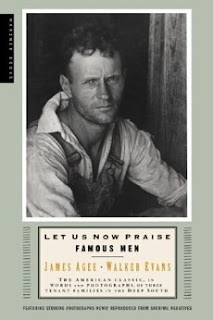In July and August 1936, James Agee and Walker Evans were working on an article for a New York magazine in which they were to create a "photographic and verbal record" of "cotton tenantry in the United States." In particular, they were to write about "the daily living and environment of an average white family of tenant farmers." As it turned out, finding a "representative" sample of white tenant farmers proved difficult, but they found a group of three families and lived with them for less than four weeks, with Agee creating a written record and Evans taking photographs. The article was not published, and the book went through multiple publishers before finally coming out in 1939.
Let Us Now Praise Famous Men is, as Bill Stott argues, a beautifully-made 1930s documentary; Evans' photos have long since become iconic, and Agee's prose claims the entire beat generation as its descendants. Agee is also careful to situate himself and Evans as characters within the story of the tenant farmers' lives, so that the reader is clear throughout that the book combines objective reality and normative interpretation. The main argument of the book is encapsulated in the verse that serves as its title: "let us now praise famous men, and our fathers that begat us." The tension here is important: while the famous men lead us in creating history and are thus written down and remembered in history books, they are also responsible for the poverty in which his subjects live; while our fathers' names are never known to the world, they are arguably more important, because without fathers there would be no children, no next generation to pass history down to. Thus he celebrates the particularity of the human life of his subjects even as he critiques the universal structures that create it.

No comments:
Post a Comment